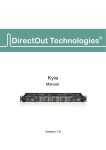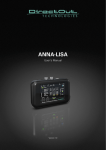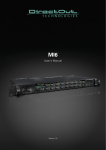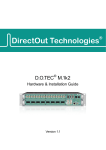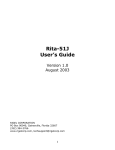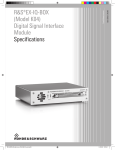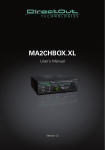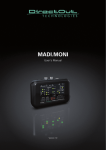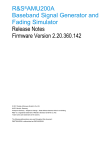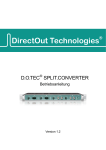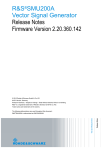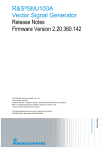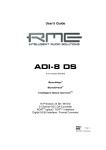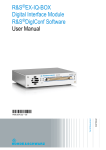Download ANDIAMO Manual
Transcript
DirectOut Technologies D.O.TEC® ANDIAMO Manual Version 1.6 ® DirectOut Technologies® Copyright Note Copyright All rights reserved. Permission to reprint or electronically reproduce any document or graphic in whole or in part for any reason is expressly prohibited, unless prior written consent is obtained from the DirectOut GmbH. All trademarks and registered trademarks belong to their respective owners. It cannot be guaranteed that all product names, products, trademarks, requisitions, regulations, guidelines, specifications and norms are free from trade mark rights of third parties. All entries in this document have been thoroughly checked; however no guarantee for correctness can be given. DirectOut GmbH cannot be held responsible for any misleading or incorrect information provided throughout this manual. DirectOut GmbH reserves the right to change specifications at any time without notice. DirectOut Technologies® and D.O.TEC® are a registered trademarks of the DirectOut GmbH. © DirectOut GmbH, 2012 page 2 of 49 ® D.O.TEC ANDIAMO Manual - Version 1.6 © 2012 DirectOut GmbH DirectOut Technologies® Table of Contents Table of contents About This Manual 5 How to Use This Manual Conventions 5 5 Chapter 1: Overview 6 Introduction6 Feature Summary 6 Applications7 Chapter 2: Legal issues & facts 8 Before Installing This Device 8 Defective Parts/Modules 8 First Aid (in case of electric shock) 9 Contents 10 Accessories10 Updates 12 Intended Operation 12 Conditions of Warranty 12 Conformity & Certificates 13 Contact 13 Chapter 3: Installation 14 Installing the Device 14 Chapter 4: Operation 17 Introduction 17 Global Control 17 Menu Control 18 Clocking19 Sample Rates 20 Level Settings 21 Level Meters 22 Output Format 23 Bank Selection / Signal Routing 24 MADI / Word clock / USB 26 Analog Input / Output 27 Delay Compensation 28 Chapter 5: Menu Navigation 31 Chapter 6 - ANDIAMO Remote 33 Remote Control 33 Connecting the device 33 Monitoring35 System Setup 36 Routing Matrix 37 Presets40 Error Messages 43 © 2012 DirectOut GmbH ® D.O.TEC ANDIAMO Manual - Version 1.6 page 3 of 49 DirectOut Technologies® Chapter 7: Troubleshooting and Maintenance 44 Troubleshooting44 Maintenance44 Chapter 8: Technical Data 45 Appendix A: Wiring DSUB-25 47 DSUB-25 - analog page 4 of 49 47 Appendix B: Configuration Examples 48 Index 49 ® D.O.TEC ANDIAMO Manual - Version 1.6 © 2012 DirectOut GmbH DirectOut Technologies® About This Manual About this Manual how to use this Manual This manual guides you through the installation and operation of the ANDIAMO. Use the Table of Contents at the beginning of the manual or Index Directory (page 49) to locate help on a particular topic. You can access more information and latest news by visiting on the DirectOut website at www.directout.eu. Conventions The following symbols are used to draw your attention to: tips – indicate useful tips and shortcuts. notes – are used for important points of clarification or cross references. warning Warnings – alert you when an action should always be observed. © 2012 DirectOut GmbH ® D.O.TEC ANDIAMO Manual - Version 1.6 page 5 of 49 DirectOut Technologies® Chapter 1: Overview Chapter 1: overview introduction Welcome to the ANDIAMO, D.O.TEC’s s high quality AD/DA converter for MADI signals. The ANDIAMO provides one MADI input and output and 32 channels analog inputs and outputs. With one RU height, two redundant power supplies and excellent sounding converters the device offers best and safe audio quality at a minimal need of rackspace. ANDIAMO - SC version (optical) ANDIAMO - BNC version (coaxial) feature summary page 6 of 49 MADi ports 1 x MADI input and output SC multi-mode connectors (optical version) or coaxial BNC connectors (coaxial version) MADi formats 56/64 channel, 48k/96k Frame, S/MUX 2 sample rates 44.1, 48, 88.2, 96 kHz +/-12.5% Clock inputs 1 x Word clock coaxial BNC (75 Ω termination switchable) This input also accepts an AES3 frame (AES11). Clock output 1 x Word clock coaxial BNC ® D.O.TEC ANDIAMO Manual - Version 1.6 © 2012 DirectOut GmbH DirectOut Technologies® Chapter 1: Overview line inputs 4 x DSUB-25 (8 channels each) line outputs 4 x DSUB-25 (8 channels each) usb port USB 2.0 port for firmware updates and remote control. power supply This device is equipped with two wide range power supplies (84 V to 264 V AC / 47 Hz to 63 Hz / safety class 1). Applications ANDIAMO can be used for conversion, monitoring and recording of analog signals. Typical applications include: • monitoring digital audio • recording line signals • conversion of a high number of channels from analog to digital and vice versa • cascaded use of two ANDIAMOs for conversion of all 64 channels of a MADI signal • format conversion of MADI signals • ... analog in - 4 x 8 channels MADI In MADI Out analog out - 4 x 8 channels © 2012 DirectOut GmbH ® D.O.TEC ANDIAMO Manual - Version 1.6 page 7 of 49 DirectOut Technologies® Chapter 2: Legal issues & facts Chapter 2: legal issues & facts before installing this Device warning Please read and observe ALL of the following notes before installing this product: • Check the hardware device for transport damage. • Any devices showing signs of mechanical damage or damage from the spillage of liquids MUST NOT be connected to the mains supply, or disconnected from the mains immediately by pulling out the power lead. • All devices MUST be grounded. The device is grounded through its IEC power connections. • All devices MUST be connected to the mains using the threecord power leads supplied with the system. Only supply electrical interfaces with the voltages and signals described in these instructions. • Do NOT use the device at extreme temperatures. Proper operation can only be guaranteed between temperatures of 5º C and 45º C and a maximum relative humidity of 80 %, noncondensing. • The cabinet of the device will heat up. DO NOT place the device close to heating sources (e.g. heaters). Observe the environmental conditions. Defective parts/Modules warning This device contains no user-serviceable parts. Therefore do NOT open the device. In the event of a hardware defect, please send the device to your D.O.TEC® representative together with a detailed description of the fault. We would like to remind you to please check carefully whether the failure is caused by erroneous configuration, operation or connection before sending parts for repair. See „Chapter 7: Troubleshooting and Maintenance“ on page 44 for assistance with troubleshooting. page 8 of 49 ® D.O.TEC ANDIAMO Manual - Version 1.6 © 2012 DirectOut GmbH DirectOut Technologies® Chapter 2: Legal issues & facts first Aid (in case of electric shock) warning • DO NOT touch the person or his/her clothing before power is turned off, otherwise you risk sustaining an electric shock yourself. • Separate the person as quickly as possible from the electric power source as follows: Switch off the equipment. Unplug or disconnect the mains cable. • Move the person away from the power source by using dry insulating material (such as wood or plastic). • If the person is unconscious: Check their pulse and reanimate if their respiration is poor. Lay the body down and turn it to one side. Call for a doctor immediately. • Having sustained an electric shock, ALWAYS consult a doctor. © 2012 DirectOut GmbH ® D.O.TEC ANDIAMO Manual - Version 1.6 page 9 of 49 DirectOut Technologies® Chapter 2: Legal issues & facts Contents The contents of your ANDIAMO package should include: • 1 x ANDIAMO (19’’, 1 RU) • 2 x power chord • 2 x fixing unit for power plug • 1 x Manual Accessories D.O.TEC® BREAKOUT series The BREAKOUT Series are adaptor boxes - available in different variants - to widen the application range of the D.O.TEC ® ANDIAMO 2 series. Each box is equipped with XLR or BNC connectors at the front panel and DSUB-25 connectors at the rear panel. Audio signals are carried passively between front and rear panel. Five different models are available: BREAKOUT.AN8 - analog input / output, 8 channels BREAKOUT.AN16I - analog input, 16 channels BREAKOUT.AN16O - analog output, 16 channels page 10 of 49 ® D.O.TEC ANDIAMO Manual - Version 1.6 © 2012 DirectOut GmbH DirectOut Technologies® Chapter 2: Legal issues & facts BREAKOUT.AES - digital input / output, 8 AES ports (16 channels) BREAKOUT.AESid - digital input / output, 16 AESid ports (32 channels) © 2012 DirectOut GmbH ® D.O.TEC ANDIAMO Manual - Version 1.6 page 11 of 49 DirectOut Technologies® Chapter 2: Legal issues & facts updates D.O.TEC® products are continually in development, and therefore the information in this manual may be superseded by new releases. To access the latest documentation, please visit the DirectOut website: www.directout.eu. This guide refers to firmware version 2.5. intended operation The ANDIAMO is designed for conversion of audio signals from analog to digital and vice versa. In this context digital audio refers to a MADI signal (AES10). warning No compensation can be claimed for damages caused by operation of this unit other than for the intended use described above. Consecutive damages are also excluded explicitly. The general terms and conditions of business of DirectOut GmbH are applied. Conditions of warranty This unit has been designed and examined carefully by the manufacturer and complies with actual norms and directives. Warranty is granted by DirectOut GmbH over the period of two years for all components that are essential for proper and intended operation of the device. The date of purchase is applied for this period. warning All claims of warranty will expire once the device has been opened or modified, or if instructions and warnings were ignored. For warranty claims please contact the dealer where your device was acquired. page 12 of 49 ® D.O.TEC ANDIAMO Manual - Version 1.6 © 2012 DirectOut GmbH DirectOut Technologies® Chapter 2: Legal issues & facts Conformity&Certificates Ce This device complies with the basic requests of applicable EU guidelines. The appropriate procedure for approval has been carried out. rohs (Restriction of the use of certain Hazardous Substances) This device was constructed fulfilling the directive on the restriction of the use of certain hazardous substances in electrical and electronic equipment 2002/95/EC. weee (Directive on Waste Electrical and Electronic Equipment) Due to the directive 2002/96/EC for waste disposal this device must be recycled. For correct recycling please dispatch the device to: IMM Elektronik GmbH, Leipziger Strasse 32 09648 Mittweida Germany Only stamped parcels will be accepted! WEEE-Reg.-No. DE 93924963 Contact Sales: DirectOut GmbH, Leipziger Strasse 32, 09648 Mittweida, Germany Phone: +49 (0)3727 6205-333 // Fax: +49 (0)3727 6205-56 www.directout.eu Manufacturer: IMM Elektronik GmbH, Leipziger Strasse 32, 09648 Mittweida, Germany Phone: +49 (0)3727 6205-0 // Fax: +49 (0)3727 6205-56 www.imm-gruppe.de © 2012 DirectOut GmbH ® D.O.TEC ANDIAMO Manual - Version 1.6 page 13 of 49 DirectOut Technologies® Chapter 3: Installation Chapter 3: installation installing the Device 1. Open the packaging and check that the contents have been delivered complete and undamaged. 2. Fix the device in a 19’’ frame with four screws, or place it on a non-slip horizontal surface. warning Avoid damage from condensation by waiting for the device to adapt to the environmental temperature. Proper operation can only be guaranteed between temperatures of 5º C and 45º C and a maximum relative humidity of 80%, non-condensing. Ensure that the unit has sufficient air circulation for cooling. 3. Remove the protective cap from the optical MADI port before use (SC version only). Retain the protective cap if an optical port is unused. This will protect against soiling which can lead to malfunction. 4. Connect signal cable for the MADI signals. ANDIAMO - SC version (optical) ANDIAMO - BNC version (coaxial) page 14 of 49 ® D.O.TEC ANDIAMO Manual - Version 1.6 © 2012 DirectOut GmbH DirectOut Technologies® Chapter 3: Installation 5. Connect the signal cables1 for the analog audio signals to the DSUB-25 connectors (TASCAM pinout). warning Do not connect voltage sources to the analog outputs. This may cause damage at the output stages. Observe the technical specifications - see „Chapter 8: Technical Data“ on page 45. 6. Optional: Connect an USB cable to the USB port for remote control or firmware updates. This requires the D.O.TEC® USB driver (Windows) being installed first. The driver and the installation instructions are available at www.directout.eu. Link: http://www.directout.eu/en/support/downloads/andiamo.html 7. Using the power cords provided connect both PSUs to a matching power supply: warning This device Must be connected to the mains using the three-cord power leads supplied with the system. Only supply the voltages and signals indicated (84V – 264V). This device may operate with only one power supply. To provide power supply redundancy, it is recommended to connect both PSU 1 and PSU 2 to independent power supplies with separate fuses. 1 signal cables are not included in delivery © 2012 DirectOut GmbH ® D.O.TEC ANDIAMO Manual - Version 1.6 page 15 of 49 DirectOut Technologies® Chapter 3: Installation 8. Turn on the power switch and check the status of PSUs on the front panel: The first seconds after switch-on the actual firmware is indicated by the lower metering panel - e.g. firmware version 2.5. Use the D.O.TEC® Release Map to match your D.O.TEC® device with the latest firmware or software release. Link: http://www.directout.eu/upload/dokumente/dotec_release_map.pdf To update the firmware an installed D.O.TEC® USB driver (Windows) and the D.O.TEC® Update Tool are necessary. The software and the installation instructions are available at www.directout.eu. Link: http://www.directout.eu/en/support/downloads/andiamo.html Keep any packaging in order to protect the device should it need to be dispatched for service. page 16 of 49 ® D.O.TEC ANDIAMO Manual - Version 1.6 © 2012 DirectOut GmbH DirectOut Technologies® Chapter 4: Operation Chapter 4: operation introduction This chapter describes the basic operation of the device. Note that throughout this manual, the abbreviation FS refers to sample rate or sample frequency. So, when dealing with scaling factors, the following sample rates can be written as: • 44.1 kHz = 1 FS; 88.2 kHz = 2 FS or • 48 kHz = 1 FS; 96 kHz = 2 FS global Control The control on the right of the front panel indicates the power supply. Power switches are on the back panel: power 2 switches Enable / disable power supply. psu 1 & psu 2 2 leDs (green): indicate the status of both power supply units LED OFF = Power supply inactive LED ON = Power supply active The green LEDs (PSU 1 & PSU 2) indicate that a working power supply is connected to the power supply unit. Note that an unlit LED does not guarantee that the device is free of voltage. To ensure that the device is completely disconnected from mains voltage, the power chords must be disconnected. © 2012 DirectOut GmbH ® D.O.TEC ANDIAMO Manual - Version 1.6 page 17 of 49 DirectOut Technologies® Chapter 4: Operation Menu Control The system settings of the converter can be accessed using a simple menu. Two push buttons are used for navigation and settings. seleCt button Press longer than 2 seconds to enter the menu. Press short for navigation in menu mode. set button Press to adjust a setting. Only active in menu mode. When the menu mode is active a LED will blink in one of the sections while the remaining LEDs of this section are glowing weak. This indicates: • a setting can be adjusted in this section • the blinking LED is the selected option in this section After a short period of time the menu mode is exit automatically. See also „Chapter 5: Menu Navigation“ on page 31. Blinking LEDs are also used to indicate an error (e.g. missing sync). Concentrate on the section where one LED is blinking and the remaining LEDs are glowing weak. page 18 of 49 ® D.O.TEC ANDIAMO Manual - Version 1.6 © 2012 DirectOut GmbH DirectOut Technologies® Chapter 4: Operation Clocking The system clock can be set to one of three possible clock sources in the menu (see „Chapter 5: Menu Navigation“ on page 31). The LEDs on the front panel inform about selection and lock/sync state1 of the selected source. 75Ω leD (yellow): indicates the termination status of the word clock input LED ON = Termination active LED OFF = Termination inactive wCK leD (green): indicates use of word clock as clock source LED ON = Clock source set to word clock LED blinking = Clock source set to word clock and no signal present LED heartbeat = Signal locked but not in sync MADi leD (green): indicates use of MADi input as clock source LED ON = Clock source set to MADI input LED blinking = Clock source set to MADI input and no signal present LED heartbeat = Signal locked but not in sync If there is no MADI input signal present, one of the LEDs <Output level> is blinking slowly. int 1 leD (green): indicates use of internal clock generator as clock source LED ON = Clock source set to internal clock generator Lock = a valid signal is detected but its clock does not match with the system reference Sync = a valid signal is detected and matches with the system reference © 2012 DirectOut GmbH ® D.O.TEC ANDIAMO Manual - Version 1.6 page 19 of 49 DirectOut Technologies® Chapter 4: Operation sample rates The scaling factor and the sample rate are indicated by three LEDs. With the clock set to internal (INT) the sample rate can be adjusted in the menu. All other clock sources (word clock, MADI) define the base rate automatically. When a MADI signal is used as clock source, the device will switch to 2 FS operation automatically when a 96k Frame signal has been detected. With 48k Frame signals no distinction is possible between 1 FS and 2 FS - so the scaling factor has to be set manually. 2 fs leD (yellow): indicates scaling factor of operation LED ON = Scaling factor of sample rate set to 2 FS A 96k Frame signal forces to 2 FS. 48k leD (green): indicates the use of 48 khz as base sample rate. LED ON = Base sample rate set to 48 kHz 44.1k leD (green): indicates the use of 44.1 khz as base sample rate. LED ON = Base sample rate set to 44.1 kHz If the clock source is set to word clock or MADI input no adjustment of the base rate is possible - the measured frequency of the clock source is indicated then. page 20 of 49 ® D.O.TEC ANDIAMO Manual - Version 1.6 © 2012 DirectOut GmbH DirectOut Technologies® Chapter 4: Operation level settings The sensitivity of the AD and DA converters can be switched between two settings (high and low) where the analog level corresponds to 0 dBFS. Depending on the model of the ANDIAMO the sensitivity levels are different. Four LEDs inform about the sensitivity that can be adjusted for input and output separately. in leD (green): indicates the adjusted sensitivity of the converter. LED ON = +6 dBU (+9 dBU / +15 dBU) LED OFF = +15 dBU (+18 dBU / +24 dBU) out leD (green): indicates the adjusted sensitivity of the converter. LED ON = +6 dBU (+9 dBU / +15 dBU) LED OFF = +15 dBU (+18 dBU / +24 dBU) With the level setting to “low” a digital gain (input) or a digital reduction (output) is applied to adapt the lower analog level (-9 dB). If there is no MADI input signal present, one of the LEDs <Output level> is blinking slowly. The model of the ANDIAMO is a configure to order option. It is marked at the rear panel of the device. © 2012 DirectOut GmbH ® D.O.TEC ANDIAMO Manual - Version 1.6 page 21 of 49 DirectOut Technologies® Chapter 4: Operation level Meters All 32 channels have individual signal metering each with three LEDs. As the sensitivity of the converters may be varied the trigger threshold of each LED corresponds to the digital scale (dbFS). page 22 of 49 ovr leD (red): indicates an analog input overload LED ON = analog input signal equals to more than -0.5 dBFS sig (input) leD (green): indicates signal level of channel input LED ON = analog input signal equals to more than -80 dBFS The light intensity of the LEDs depends on the audio level. sig (output) leD (green): indicates signal level of channel output LED ON = analog output signal equals to more than -80 dBFS The light intensity of the LEDs depends on the audio level. ® D.O.TEC ANDIAMO Manual - Version 1.6 © 2012 DirectOut GmbH DirectOut Technologies® Chapter 4: Operation output format The format of the MADI output signal can be defined - allowing for format conversion of the MADI signal. The output signal status is indicated by two LEDs. 56 ch leD (green): indicates the channel format (64 ch or 56 ch) of the MADi output signal. LED ON = MADI output is set to 56 (28) channel mode. LED OFF = MADI output is set to 64 (32) channel mode. 96k leD (yellow): indicates the frame format @2 fs (48k frame or 96k frame) of the MADi output signal. LED ON = MADI output is set to 96k Frame LED OFF = MADI output is set to 48k Frame 96k Frame is available with 2 FS only. © 2012 DirectOut GmbH ® D.O.TEC ANDIAMO Manual - Version 1.6 page 23 of 49 DirectOut Technologies® Chapter 4: Operation bank selection / signal routing At a scaling factor of 1 FS the bank selection defines the block of channels in the MADI stream that are routed to the DA converters. The outgoing MADI channels in the same block will be replaced by the audio signals from the AD converters. The remaining MADI data passes the device unchanged. The bank selection is indicated by two LEDs. At 2 FS operation a maximum of 32 channels are transmitted in a MADI signal; so there is no selection possible then. The LEDs for the bank selection are also used to indicate the activation status of the ‘Matrix Mode’ (see page 25) and delay compensation. 33..64 leD (green): indicates the selection of the converted audio channels. LED ON = audio channels 33 to 64 (29 to 56 of a 56 ch signal) are converted LED heartbeat = delay compensation active, audio channels 33 to 64 are converted 1..32 leD (green): indicates the selection of the converted audio channels. LED ON = audio channels 1 to 32 (1 to 28 of a 56 ch signal) are converted. LED heartbeat = delay compensation active, audio channels 1 to 32 are converted See „Delay Compensation“ on page 28 for more information about cascading of ANDIAMOs. If both Bank LEDs are <ON> ‘Matrix Mode’ is enabled. If both Bank LEDs <heartbeat> ‘Matrix Mode’ is enabled and delay compensation is active. page 24 of 49 ® D.O.TEC ANDIAMO Manual - Version 1.6 © 2012 DirectOut GmbH DirectOut Technologies® Chapter 4: Operation Matrix Mode Two methods of signal routing are available: a) ‘Standard Bank Routing’ - signal routing of analog and digital I/Os as a whole. b) ‘Matrix Mode’ - individual signal routing of all analog and digital I/Os on a per channel basis. To setup an individual routing the remote control software (ANDIAMO Remote) is required. The settings of the routing matrix are stored inside the device. So it is possible to toggle between both routing methods without using the remote control - see „Chapter 5: Menu Navigation“ on page 31. © 2012 DirectOut GmbH ® D.O.TEC ANDIAMO Manual - Version 1.6 page 25 of 49 DirectOut Technologies® Chapter 4: Operation ANDIAMO - SC version (optical) ANDIAMO - BNC version (coaxial) MADi / word clock / usb A word clock signal output provides the system clock that is either derived from word clock input, MADI input or internal clock generator. The MADI ports are used for transmission of 64 audio channels (AES10). The USB port is used for firmware updates and for remote control using a software remote application (Windows PC). page 26 of 49 word clock output bnC socket (coaxial) System clock output - connect for word clock output signal here. word clock input bnC socket (coaxial) Connect word clock or AES3 DARS (Digital Audio Reference Signal) here. usb usb socket (type b) Connect for firmware updates and remote control here. MADi in sC socket (optical) or bnC socket (coaxial) MADI input (64 ch), connect MADI input here MADi out sC socket (optical) or bnC socket (coaxial) MADI output (64 ch), connect MADI output here ® D.O.TEC ANDIAMO Manual - Version 1.6 © 2012 DirectOut GmbH DirectOut Technologies® Chapter 4: Operation Analog input / output Eight DSUB-25 ports (4 x input / 4 x output) are used for transmission of the analog audio signals. Each port transmits eight audio channels. TASCAM1 pinout is used - see „Appendix A: Wiring DSUB-25“ on page 47 for wiring sketch. Analog input (1-8) Dsub-25 port Analog audio input connect audio channels 1-8 here Analog input (9-16) Dsub-25 port Analog audio input connect audio channels 9-16 here Analog input (17-24) Dsub-25 port Analog audio input connect audio channels 17-24 here Analog input (25-32) Dsub-25 port Analog audio input connect audio channels 25-32 here Analog output (1-8) Dsub-25 port Analog audio output connect audio channels 1-8 here Analog output (9-16) Dsub-25 port Analog audio output connect audio channels 9-16 here Analog output (17-24) Dsub-25 port Analog audio output connect audio channels 17-24 here Analog output (25-32) Dsub-25 port Analog audio output connect audio channels 25-32 here warning Do not connect voltage sources to the analog outputs. This may cause damage at the output stages. Observe the technical specifications - see „Chapter 8: Technical Data“ on page 45. 1 TASCAM is a registered trademark of TEAC corporation. © 2012 DirectOut GmbH ® D.O.TEC ANDIAMO Manual - Version 1.6 page 27 of 49 DirectOut Technologies® Chapter 4: Operation Delay Compensation There is a delay of three samples between MADI input and output. For conversion of all 64 channels (@ 1 FS) of a MADI signal two ANDIAMOs may be cascaded. To ensure phase locked operation of all audio channels the delay between two ANDIAMOs will be compensated then. Delay compensation becomes active, if an ANDIAMO ‘sees’ another ANDIAMO at its input. The ‘second’ ANDIAMO will switch to ID 02. Indication of ID 2: LED <bank selection> heartbeat (see page 24). Delay compensation: Δt A/D Δt D/A iD 01 0 +3 samples iD 02 +3 samples 0 MADI IN 01 ID 01 Δt = 3 samples MADI OUT 01 MADI IN 02 ID 02 MADI OUT 02 Two ANDIAMOs cascaded To ensure proper detection for delay compensation no other device must be connected in between two ANDIAMOs. page 28 of 49 ® D.O.TEC ANDIAMO Manual - Version 1.6 © 2012 DirectOut GmbH DirectOut Technologies® Chapter 4: Operation ‘Digital snake’ Four ANDIAMOs may be cascaded to build a ‘digital snake’; i.e. transmission of 64 audio channels from location ‘a’ to location ‘b’ and vice versa. In this case all ANDIAMOs are set to ID 02 and no delay compensation is applied. The LED bank selection will heartbeat on all devices. To achieve an equal amount of latency relative to all channels it is important to set the bank selection according the order: ‘01..32’ ‘33..64’ ‘01..32’ ‘33..64’ The effective latency between location ‘a’ and location ‘b’ (and vice versa) will total in six samples. effective latency ‚b‘ to ‚a‘ = 6 samples MADI OUT 02b MADI IN 01a Δt = 3 samples ID 02 ID 02 Δt = 3 samples MADI OUT 01a Δt = 3 samples MADI IN 02a MADI IN 02b MADI OUT 01b ID 02 ID 02 Δt = 3 samples MADI OUT 02a MADI IN 01b effective latency ‚a‘ to ‚b‘ = 6 samples ‘Digital Snake’ - four ANDIAMOs cascaded © 2012 DirectOut GmbH ® D.O.TEC ANDIAMO Manual - Version 1.6 page 29 of 49 DirectOut Technologies® Chapter 4: Operation This page is left blank intentionally page 30 of 49 ® D.O.TEC ANDIAMO Manual - Version 1.6 © 2012 DirectOut GmbH DirectOut Technologies® Chapter 5: Menu Navigation Chapter 5: Menu navigation To setup the converter the menu mode has to be entered first. The unit will switch back to idle mode automatically after timeout. LED To enter the Menu Press > 2 s <SELECT> Function Clock set internally INT Press <SET> Press <SET> WCK Clock set to MADI input Clock MADI Clock set to Word clock (Termination off) Press <SET> Clock set to Word clock (Termination on) WCK + 75Ω Press <SET> Press <SELECT> Sample rate = 44.1 kHz (clock source INT) 44.1k 48k Press <SET> 44.1k + 2 FS Press <SET> Sample Rate Press <SET> Sample rate = 48 kHz (clock source INT) Sample rate = 88.2 kHz Sample rate = 96 kHz 48k + 2 FS Press <SET> Press <SELECT> Matrix Mode enabled Press <SELECT> Press <SET> 1..32 Press > 2 s <SET> 33..64 33..64 Press <SET> overrides bank selection Bank 1..32 Channels 1-32 selected Channels 33-64 selected (only @1 FS) Press <SELECT> 64 ch Mode, 48kFrame no LED Press <SET> Press <SET> 96k 56 ch Mode, 96kFrame (only @2 FS) Format 56 ch + 96k 64 ch Mode, 96kFrame (only @2 FS) Press <SET> 56 ch Mode, 48kFrame 56 ch Press <SET> Press <SELECT> Press <SET> low Press <SET> Input Level high Input high level +15 / +18 / +24 dBU (= 0dBFS) Input low level +6 / +9 / +15 dBU (= 0dBFS) Press <SELECT> Press <SET> low Press <SET> © 2012 DirectOut GmbH Output Level high Output high level +15 / +18 / +24 dBU (= 0dBFS) Output low level +6 / +9 / +15 dBU (= 0dBFS) ® D.O.TEC ANDIAMO Manual - Version 1.6 page 31 of 49 DirectOut Technologies® Chapter 5: Menu Navigation In menu mode the active parameter for adjusting is indicated by a blinking LED. This LED reflects the setting of this parameter. System Settings parameter <Clock> Three different clock sources: word clock, MADI, internal Internal allows for changing the base sample rate. parameter <sample rate> Two base sample rates: 44.1 kHz and 48 kHz Two scaling factors: 1 FS and 2 FS The setting of the base sample rate only affects the conversion with the clock source set to INT. If the clock source is set to word clock or MADI input no adjustment is possible - the measured frequency of the clock source is indicated then. parameter <bank> Two banks allow for selection of 32 audio channels out of 64 audio channels at a scaling factor of 1 FS. At 2 FS only 32 audio channels are transmitted in a MADI signal. ‘Matrix Mode’ can be activated or disabled. parameter <format> The channel format (56 ch or 64 ch) as well as the frame format (48k Frame or 96k Frame) of the MADI output can be adjusted. This setting does not affect the input signal. parameter <input level> The converter offers the ability to change the sensitivity of its analog inputs corresponding to 0 dBFS. Depending on the model these levels are different: • Model A: +15 dBU (high) / +6 dBU (low) • Model B: +18 dBU (high) / +9 dBU (low) • Model C: +24 dBU (high) / +15 dBU (low) parameter <output level> As for the input level the output signal @at 0 dBFS can also be calibrated to two different levels. Three different models are available - see <Input Level>. page 32 of 49 ® D.O.TEC ANDIAMO Manual - Version 1.6 © 2012 DirectOut GmbH DirectOut Technologies® Chapter 6 - ANDIAMO Remote Chapter 6 - AnDiAMo remote remote Control The ANDIAMO can be remote controlled by a remote software application - ANDIAMO Remote - running on a Windows PC. Supported OS versions are Windows XP, Vista and 7. The software may control the device using three different methods: a) Serial control via USB b) Serial over MADI (embedded RS-232 data) c) MIDI over MADI (embedded MIDI data) All settings are stored inside the device. An offline mode allows to prepare settings and to store them to file for later use. Remote control requires firmware version 2.5 or higher - see „Chapter 3: Installation“ on page 14ff. Connecting the device To connect with the device the method and the port must be selected. Method a) and b) both use a COM port of the operating system. Method a) requires: • USB connection to the device • installed D.O.TEC® USB driver To connect: • Select the COM port • Click ‘CONNECT’ The driver and the installation instructions are available at www.directout.eu. © 2012 DirectOut GmbH ® D.O.TEC ANDIAMO Manual - Version 1.6 page 33 of 49 DirectOut Technologies® Chapter 6 - ANDIAMO Remote Method b) requires: • installed COM port on the computer • an embedder / de-embedder Suitable embedder devices: • D.O.TEC® PRODUCER.COM • D.O.TEC® EXBOX.MIDICOM • D.O.TEC® EXBOX.AES • D.O.TEC® M1.k2 • D.O.TEC® MA2CHBOX • D.O.TEC® MA2CHBOX.XT To connect: • Select the COM port • Click ‘CONNECT’ When using method b) make sure that the baud rate of the used embedder is set to 115.200 baud. To ensure proper operation using embedded serial data a bit transparent bidirectional link of the MADI signal is required. Method c) requires: • a MIDI device to be installed on the computer • an embedder / de-embedder page 34 of 49 ® D.O.TEC ANDIAMO Manual - Version 1.6 © 2012 DirectOut GmbH DirectOut Technologies® Chapter 6 - ANDIAMO Remote Suitable embedder devices: • D.O.TEC® PRODUCER.COM • D.O.TEC® EXBOX.MIDICOM • D.O.TEC® M1.k2 • MADI card with built in embedder / de-embedder To connect: • Select MIDI I/O • Enable MIDI I/O • Click Connect To ensure proper operation using embedded MIDI data a bit transparent bidirectional link of the MADI signal is required. Monitoring The standard view monitors the system state and informs about the system settings. The bottom bar monitors the connection state with the device. Click ‘Settings’ to open the system setup dialog. Click ‘MATRIX’ to toggle the MATRIX view. Click ‘DISCONNECT’ to close the connection. Depending on the connected device the view may differ. © 2012 DirectOut GmbH ® D.O.TEC ANDIAMO Manual - Version 1.6 page 35 of 49 DirectOut Technologies® Chapter 6 - ANDIAMO Remote system setup All system settings except the configuration of the system fan control can be adjusted either locally or via the remote application. The settings are stored inside the device. Additionally presets can be stored to a file for later use. To adust the settings either click the radial buttons, checkboxes or use the pull down menus. See „Chapter 4: Operation“ on page 17 for explanation of the particular settings. Click ‘OK’ to close the dialog applying all changes. Click ‘Cancel’ to close the dialog discarding all changes. Click ‘Apply’ to transmit all changes without closing the dialog. ConfigurationSystemFan The characteristics of the system fan inside the device may be configured individually. fan slow threshold temperature fan starts at lowest speed fan fast threshold temperature fan runs at highest speed enable safe Mode fan is always running - below threshold ‘slow’ the fan runs at lowest speed The interval between ‘slow’ and ‘fast’ must amount at least to ten degrees. page 36 of 49 ® D.O.TEC ANDIAMO Manual - Version 1.6 © 2012 DirectOut GmbH DirectOut Technologies® Chapter 6 - ANDIAMO Remote routing Matrix With ‘Matrix Mode’ enabled the settings of the matrix will effect the routing of the audio signals. The matrix shows 32 inputs (horizontal) by 32 outputs (vertical). © 2012 DirectOut GmbH ® D.O.TEC ANDIAMO Manual - Version 1.6 page 37 of 49 DirectOut Technologies® Chapter 6 - ANDIAMO Remote There are three input pages (sources) and three output pages (destinations): AnAlog A/D input - D/A output MADi 1..32 MADI channel 01-32 (input / output) MADi 33..64 MADI channel 33-64 (input / output) Click the buttons to change the view of sources / destinations. Setting / deleting crosspoints: • move the cursor to the desired position - a small green square and transparent bars point the active position • click into the square to set / delete the crosspoint To set more than one crosspoint you may click and hold the left mouse button and move the cursor. The pointed crosspoints will be set upon release of the mouse button. crosspoint - output is set on the selected input page. crosspoint - output is set on a non-selected input page. page 38 of 49 ® D.O.TEC ANDIAMO Manual - Version 1.6 © 2012 DirectOut GmbH DirectOut Technologies® Chapter 6 - ANDIAMO Remote Activating Matrix Mode As described in „Matrix Mode“ on page 25 there are two methods of signal routing: a) ‘Standard Bank Routing’ - signal routing of analog and digital I/Os as a whole. b) ‘Matrix Mode’ - individual signal routing of all analog and digital I/Os on a per channel basis. There are three ways to toggle between both methods: 1. System Setup use checkbox 2. Matrix view use checkbox 3. Front panel • Activate the Menu Mode (press > 2 sec ‘SELECT’) • Step through to parameter ‘Bank’ • Press > 2 sec ‘SET’ to toggle between both methods indication Matrix Mode Matrix Mode ON Matrix Mode OFF The activation state of the ‘Matrix Mode’ is indicated in the monitoring view and on the front panel of the device. indication Delay Compensation Delay compensation active A green label indicates activated delay compensation - see „Delay Compensation“ on page 28. © 2012 DirectOut GmbH ® D.O.TEC ANDIAMO Manual - Version 1.6 page 39 of 49 DirectOut Technologies® Chapter 6 - ANDIAMO Remote presets The settings of the system and routing matrix can be stored to a single file. The settings are reloaded separately from the same file . This allows to use both settings independently from each other; e.g. you may reload another routing setup without changing the clock source. storing a preset Go to ‘Command - Save’ Enter name and click ‘Save’ to close the dialog. reloading presets page 40 of 49 ® D.O.TEC ANDIAMO Manual - Version 1.6 © 2012 DirectOut GmbH DirectOut Technologies® Chapter 6 - ANDIAMO Remote Select the file (.and) and click ‘open’ to close the dialog and proceed. A safety dialog prompts if the connection to the device is active: • Click ‘Yes’ to proceed with reloading. • Click ‘No’ to abort the operation. If no device is connected (offline mode) reloading is executed without safety dialog. © 2012 DirectOut GmbH ® D.O.TEC ANDIAMO Manual - Version 1.6 page 41 of 49 DirectOut Technologies® Chapter 6 - ANDIAMO Remote OfflineMode The offline mode allows to create or modify settings without an active connection to the device. Go to ‘Command - Offline Mode’ to activate / deactivate the offline mode. The status bar (bottom right corner) indicates ‘Not Connected’; i.e. Offline Mode is active. ‘Connect’ will terminate the offline mode. A safety dialog prompts before connecting: • Click ‘Yes’ to overwrite all settings inside the device. • Click ‘No’ to read all settings from device into software. page 42 of 49 ® D.O.TEC ANDIAMO Manual - Version 1.6 © 2012 DirectOut GmbH DirectOut Technologies® Chapter 6 - ANDIAMO Remote error Messages The selected COM port has no connection with the device. ‘Disconnect’ and check the connection (cabling, COM port). Possible reason: Abnormal termination of the connection Check the cabling or if connected device has been switched off. No MIDI device is installed. Try to connect using USB or ‘Serial over MADI’ (needs installed D.O.TEC® USB driver). © 2012 DirectOut GmbH ® D.O.TEC ANDIAMO Manual - Version 1.6 page 43 of 49 DirectOut Technologies® Chapter 7: Troubleshooting and Maintenance Chapter 7: troubleshooting and Maintenance troubleshooting To identify a possible defect with the device please consult the following table. If the fault cannot be resolved using these instructions, please contact your local D.O.TEC representative or visit support.directout.eu. issue possible reason solution Device doesn’t work. Power supply is broken. Check that the power supply switch is on, that the device is connected to the power supply and that the socket is working. Defective fuses must be exchanged by qualified service personal only. Optical port does not work. Optic is dirty. Use an air supply to carefully remove any dust. Never use objects for cleaning. No signal at the output port. Connections (input / output) are mixed up. Check the connections and change the cables if necessary. No signal at the output port. Signal cable defective. Exchange the signal cable. MADI signal at the input is not stable. Signal source is defective Change the source or use appropriate cables (see „Chapter 8: Technical Data“ on page 45). bad signal condition (Jitter > 1 ns) - e.g. due to exceeded length or bad screening attenuation of signal cable. Clicks in the audiosignal. Input source is not in sync with clock master of the device. or Check the status of input LED and check clock setting of the connected device. Maintenance To clean the device, use a soft, dry cloth. To protect the surface, avoid using cleaning agents. The device should be disconnected from the power supply during the cleaning process. page 44 of 49 ® D.O.TEC ANDIAMO Manual - Version 1.6 © 2012 DirectOut GmbH DirectOut Technologies® Chapter 8: Technical Data Chapter 8: Technical Data Dimensions • Width 19’’ (483 mm) • Height 1 HE (44.5 mm) • Depth 10’’ (254 mm) Weight • about 3 kg Power Consumption • typical 0.2 A (@84 V) up to max. 0.1 A (@264 V) • max. 0.4 A (@84 V) up to max. 0.2 A (@264 V) Power Supply • 84 V - 264 V AC / 47 Hz - 63 Hz / Safety class 1 Fuses • Fuse 250 V - 2 A (slow-blow) – 2 fuses per power supply Environmental Conditions • Operating temperature +5°C up to +45°C • Relative humidity: 10% - 80%, non condensing MADI Port (optical version) • 1 x SC socket FDDI (input / output) • ISO/IEC 9314-3 • Wave length 1310 nm • Multi-Mode 62.5/125 or 50/125 MADI Port (coaxial version) • 2 x BNC socket (input / output) • Impedance: 75 Ω • 0.3 V up to 0.6 V (peak to peak) Sample Rate • 30 - 50 kHz @1 FS • 60 - 100 kHz @2 FS MADI Format (I/O) • 48k Frame, 96k Frame • 56 channel, 64 channel • S/MUX 2 Line Input • 4 x DSUB-25 (8 analog audio channels each - balanced) © 2012 DirectOut GmbH ® D.O.TEC ANDIAMO Manual - Version 1.6 page 45 of 49 DirectOut Technologies® Chapter 8: Technical Data line output • 4 x DSUB-25 (8 analog audio channels each - balanced) A/D section • SNR: -115.5 dB RMS (20 Hz - 20 kHz) / -118 dB(A) • THD @ -1 dBFS: -113 dB • Frequency response: -0.15 dB (10 Hz) / -0.15 dB (20 kHz) • Input impedance: 20 kΩ (balanced) / 10 kΩ (unbalanced) • Input level (depending on model): Model / Level High Low Model A +15 dBu +6 dBu Model B +18 dBu +9 dBu Model C +24 dBu +15 dBu D/A section • SNR: -113.5 dB RMS (20 Hz - 20 kHz) / -116.5 dB(A) • THD @ -1 dBFS: -100 dB • Frequency response: -0.5 dB (10 Hz) / -0.15 dB (20 kHz) • Output impedance: < 50Ω • Output level (depending on model): Model / Level High Low minimum load resistance Model A +15 dBu +6 dBu 600 Ω Model B +18 dBu +9 dBu 600 Ω Model C +24 dBu +15 dBu 2,4 kΩ The outputs are not servo balanced. latency • about 1 ms (A/D - D/A) • 3 samples (MADI I/O) word Clock • 1 x BNC socket (75 Ω impedance) - input • 1 x BNC socket (75 Ω impedance) - output • WCLK signal or AES3id signal • Termination 75 Ω switchable usb • 1x USB socket (Type B) • for firmware updates and remote control (Windows PC) page 46 of 49 ® D.O.TEC ANDIAMO Manual - Version 1.6 © 2012 DirectOut GmbH DirectOut Technologies® Appendix A: Wiring DSUB-25 Appendix A: wiring Dsub-25 For the transmission of the analog audio signals DSUB-25 ports are used. As the sketch shows TASCAM1 pinout is applied. Dsub-25 - analog 1 2 3 4 5 6 7 8 G - +G - +G - +G - +G - +G - +G - +G - + 13 1 25 1 14 TASCAM is a registered trademark of TEAC corporation. © 2012 DirectOut GmbH ® D.O.TEC ANDIAMO Manual - Version 1.6 page 47 of 49 DirectOut Technologies® Index AppendixB:ConfigurationExamples example 1: Clock source is ‘word clock’ with termination enabled. Conversion of channels 01-32. Sample rate is 44.1 kHz and the analog reference levels are set to ‘low’ (-9 dB). example 2: Clock source is set to internal clock generator. Conversion of channels 01-32 (i.e. all channels)*. Matrix Mode is active. Sample rate is 96 kHz and the frame mode is set to 96k Frame at the MADI output. The analog reference levels are set to ‘high’. *) As the scaling factor is set to 2 FS, the number of available channels in the MADI signal is reduced to 32 channels. example 3: Clock source is the MADI input signal. Conversion of channels 33-64 (D/A) and channels 33-56 (A/D)*. Sample rate is 44,1 kHz. The MADI output channel format is set to ‘56 ch’. So the MADI output signal feeds 56 channels only. The analog reference levels are set to ‘high’ for the input and to ‘low’ (-9 dB) for the output. *) The setting ‘56 ch’ affects the MADI output signal only. All 32 MADI input channels are fed to the analog outputs. page 48 of 49 ® D.O.TEC ANDIAMO Manual - Version 1.6 © 2012 DirectOut GmbH DirectOut Technologies® Index Index M Matrix Mode______________________ 25 B Menu Control______________________ 18 Bank selection_____________________ 24 C Cascading________________________ 28 Conditions of Warranty see Warranty Conformity & Certificates____________ 13 Model See Level: Input / Output P Pinout See DSUB-25 S Sample Rates______________________ 6 CE�������������������������������������������������������������� 13 RoHS��������������������������������������������������������� 13 WEEE�������������������������������������������������������� 13 SNR analog / digital������������������������������������������� 46 digital / analog������������������������������������������� 46 Contact__________________________ 13 Contents_________________________ 10 Conventions_______________________ 5 System Settings___________________ 32 T THD D analog / digital������������������������������������������� 46 digital / analog������������������������������������������� 46 Defective Parts/Modules______________ 8 Delay Compensation________________ 28 Digital Gain_______________________ 21 Digital Snake______________________ 29 Dimensions_______________________ 45 DSUB-25_________________________ 47 E Environmental conditions____________ 45 Troubleshooting____________________ 44 U Updates__________________________ 12 W Warranty_________________________ 12 WEEE See Conformity & Certificates: WEEE F Feature Summary___________________ 6 Firmware_________________________ 16 First Aid___________________________ 9 Frequency Response analog / digital������������������������������������������� 46 digital / analog������������������������������������������� 46 Fuses____________________________ 45 I Impedance Input����������������������������������������������������������� 46 Output�������������������������������������������������������� 46 Intended Operation_________________ 12 L Latency A/D to D/A������������������������������������������������� 46 MADI I/O see Delay Compensation Level Input����������������������������������������������������������� Meters�������������������������������������������������������� Output�������������������������������������������������������� Settings����������������������������������������������������� 46 22 46 21 Load resistance____________________ 46 © 2012 DirectOut GmbH ® D.O.TEC ANDIAMO Manual - Version 1.6 page 49 of 49


















































